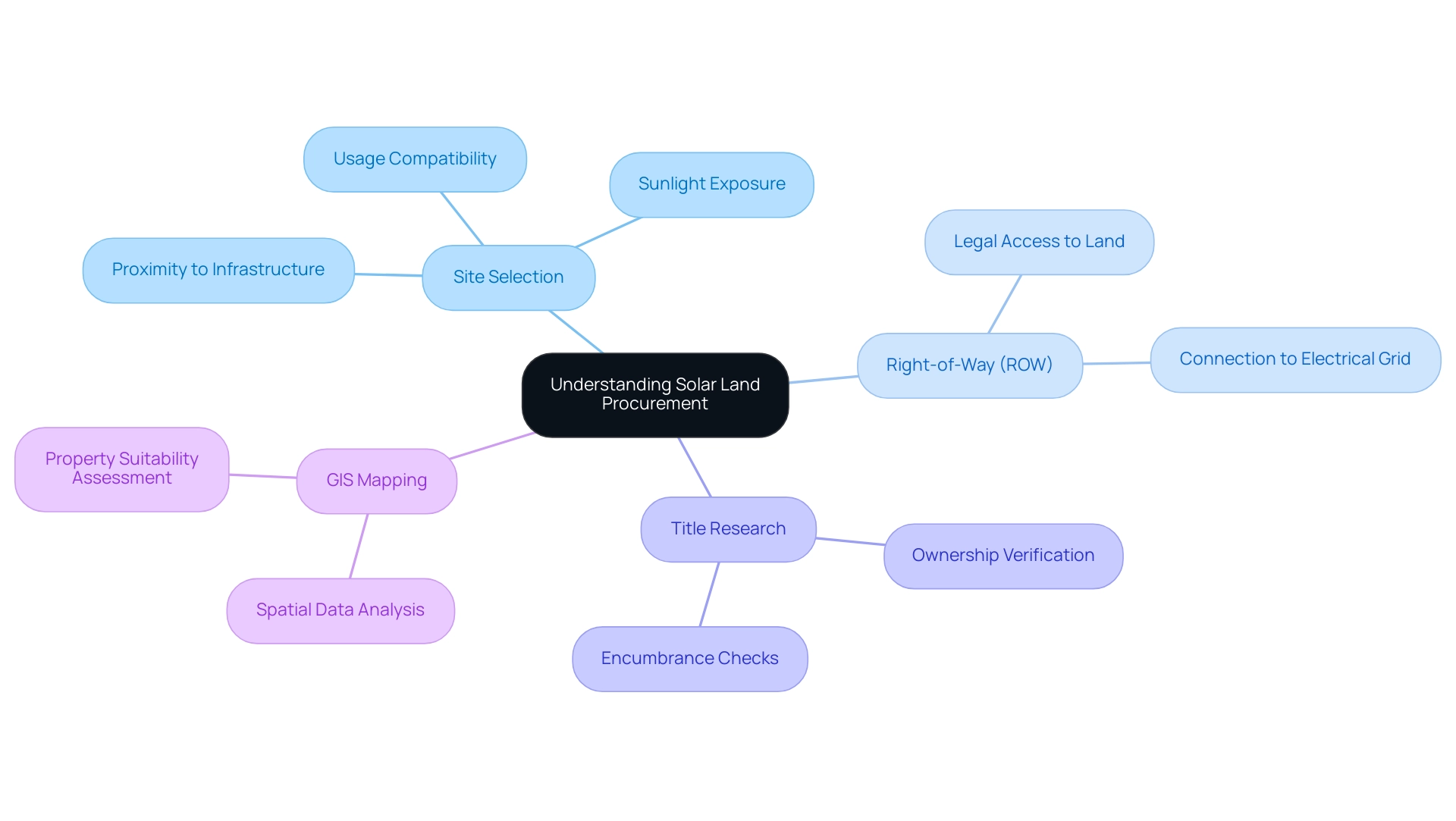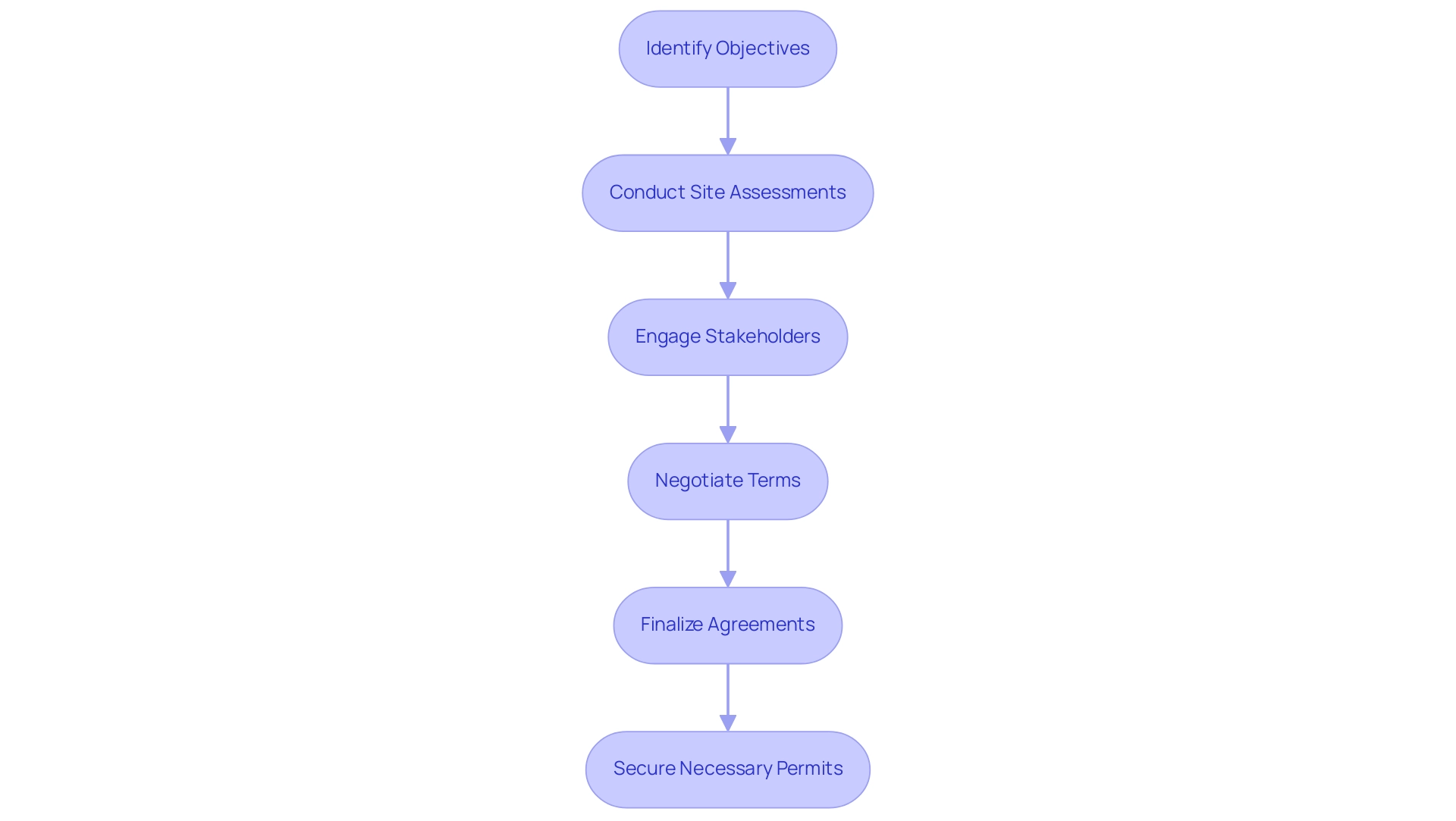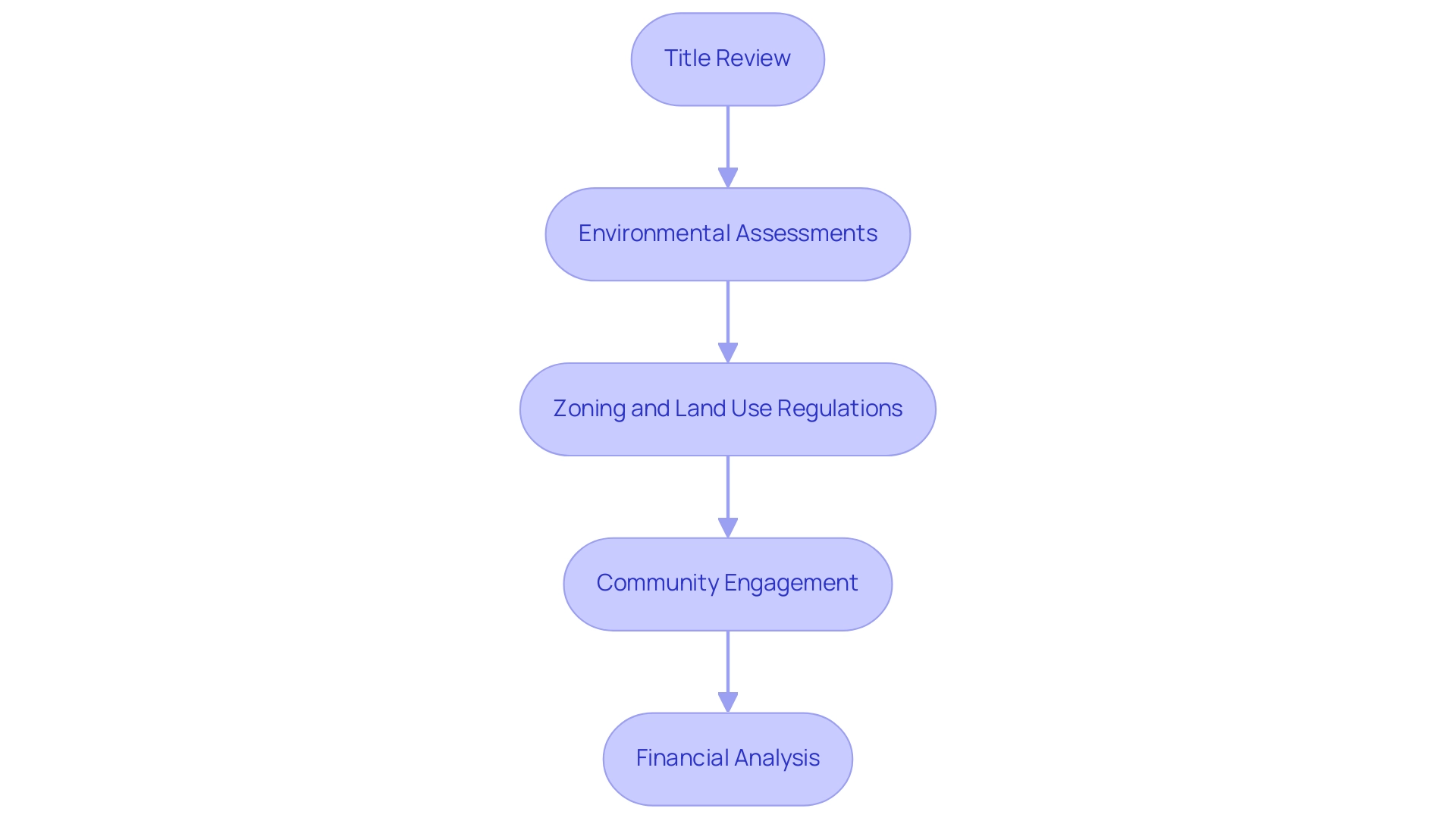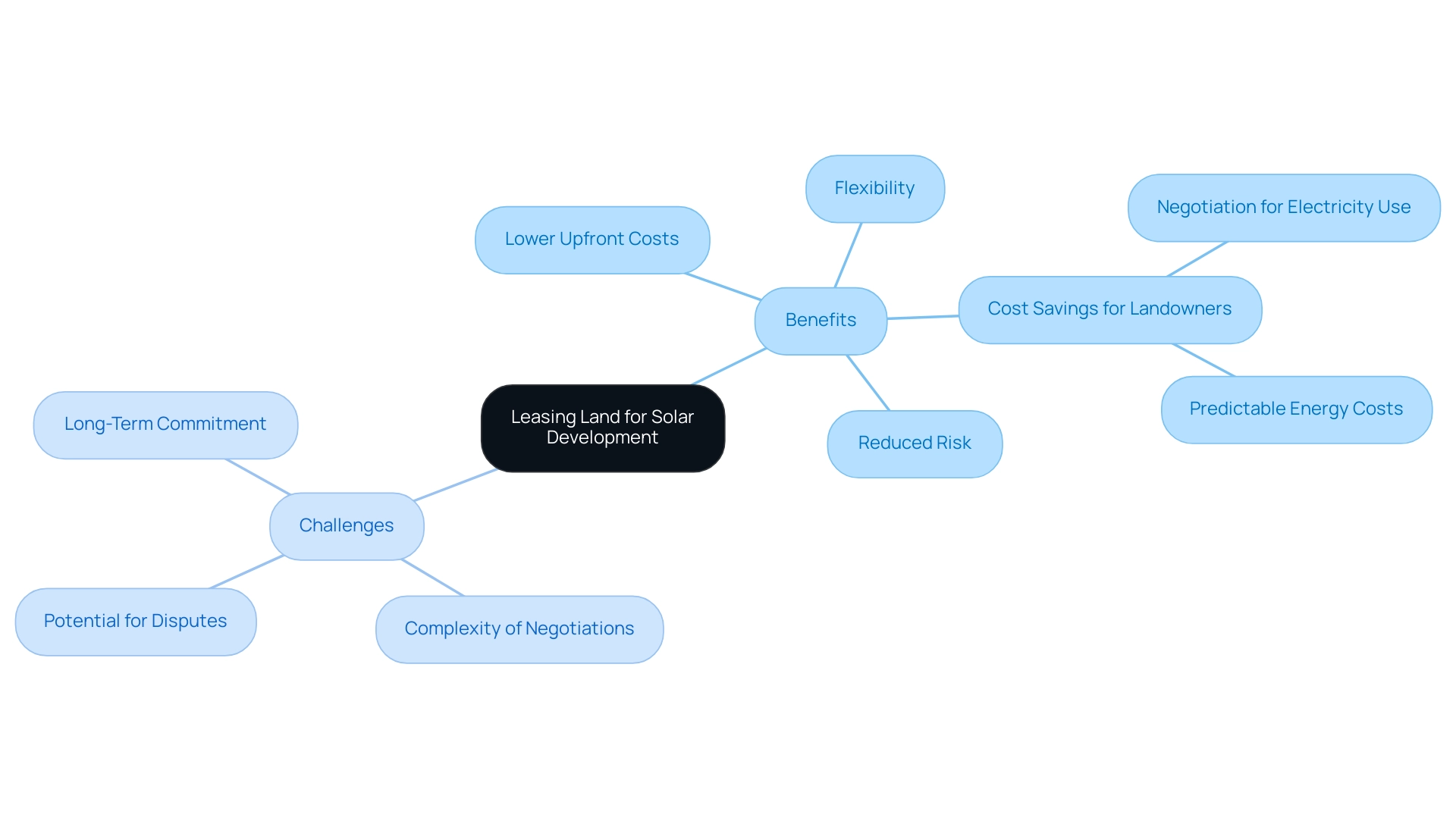Introduction
The process of solar land procurement is becoming increasingly vital as the demand for renewable energy sources grows. This intricate undertaking involves a myriad of considerations, from site selection and legal rights to environmental assessments and stakeholder engagement. Each step is essential for ensuring that solar projects can be developed efficiently and sustainably.
As the industry grapples with challenges such as interconnection issues and fluctuating market conditions, a comprehensive understanding of the land acquisition process is paramount. This article delves into the key concepts, step-by-step procedures, and the role of specialists in navigating the complexities of solar land procurement, providing valuable insights for stakeholders aiming to contribute to a cleaner energy future.
Understanding Solar Land Procurement: Key Concepts and Definitions
The process of solar land procurement for acquiring territory designated for renewable power development is crucial. Key concepts essential to this process include:
- Site Selection: This involves identifying optimal locations based on various criteria such as sunlight exposure, usage compatibility, and proximity to existing infrastructure, which is essential for efficient energy production and transmission.
- Right-of-Way (ROW): Securing the legal right to utilize specific parcels for purposes is often pivotal for accessing necessary energy transmission lines. Proper ROW agreements ensure that renewable energy initiatives can connect seamlessly to the electrical grid.
- Title Research: Conducting thorough investigations into the legal ownership of the property is crucial to confirm that the seller possesses the authority to sell and that there are no encumbrances affecting the property's use.
- GIS Mapping: Geographic Information Systems (GIS) play a significant role in analyzing spatial data, allowing stakeholders to assess property suitability comprehensively and make informed decisions based on geographic variables.
Understanding these concepts is essential for effectively navigating the solar land procurement process in renewable energy. As the renewable energy industry faces challenges such as a projected 41% drop in California's residential energy volumes and significant interconnection issues, as well as the procurement of high voltage power equipment, having a solid grasp of site selection criteria and the associated legal frameworks becomes increasingly important. Recent advancements, such as the Inspire initiative, further highlight the necessity for integrating innovative practices like agrivoltaics, which can improve land use efficiency and support sustainable power solutions.
As Ben Zientara, a renowned energy policy analyst, articulates, 'the ongoing evolution in site selection for renewable energy initiatives reflects the industry's response to both regulatory demands and market conditions.' Staying informed about these trends will assist in successful execution and alignment with broader energy objectives.

Step-by-Step Guide to Acquiring Land for Solar Projects
- Identify Objectives: Clearly define the specific requirements for your energy initiative, including desired capacity, suitable locations, and timelines. Understanding these elements is crucial for effective planning and execution.
- Conduct Site Assessments: Evaluate potential locations for energy development by considering factors such as sunlight exposure, environmental impact, and accessibility. Research has shown that flat, well-draining areas suitable for farming are also excellent locations for photovoltaic installations, leading to a requirement for creative design strategies that reduce land-use disputes. Additionally, studies indicate a four-fold increase in pollinator insects under PV panels, showcasing the environmental benefits of agrivoltaics.
- Engage Stakeholders: Initiate communication with local authorities, landowners, and community members to gauge interest and gather support for your initiative. Stakeholder involvement is progressively acknowledged as an essential element for successful renewable energy initiatives, nurturing connections that can facilitate the acquisition process.
- Negotiate Terms: Enter discussions regarding lease or purchase terms with landowners, ensuring that both parties fully understand the implications of the agreement. Clear communication during this phase can prevent misunderstandings and foster a collaborative spirit.
- Finalize Agreements: Draft and sign contracts that reflect the negotiated terms, ensuring compliance with all legal and regulatory requirements. This step is essential to protect the interests of both parties and to facilitate a smooth transition into the development phase.
- Secure Necessary Permits: Obtain all required permits and approvals from local and state authorities before commencing any development activities. This process can differ greatly in length, so it is wise to begin early to prevent delays.
By carefully adhering to these steps, stakeholders can methodically tackle the solar land procurement process for renewable energy projects. This approach not only reduces risks but also enhances efficiency, particularly in a swiftly changing environment where solar land procurement for energy systems with battery storage is becoming more prevalent. By 2028, it is anticipated that 28% of all new distributed energy capacity will be combined with storage, up from under 12% in 2023, highlighting the necessity for proactive planning in solar land procurement.
Furthermore, as indicated by the Solar PV Growth Forecast case study, over 30 GW of installations were completed through Q3 2024, establishing this technology as the leading choice for new capacity in the U.S. However, challenges such as interconnection issues and labor availability may hinder faster expansion.

Conducting Due Diligence in Solar Land Acquisition
Performing thorough research in the acquisition of photovoltaic sites is a vital procedure that includes several key steps to guarantee the initiative's success:
- Title Review: Begin by verifying the ownership of the land in question. This involves checking for any existing liens, easements, or encumbrances that could impede the acquisition or future development.
- Environmental Assessments: It is essential to assess the environmental impact of the proposed renewable energy project. This assessment should include potential effects on local wildlife, ecosystems, and any significant natural resources. Recent data reflects a growing emphasis on these evaluations, especially as major corporations, including Meta, Amazon, and Google, collectively invest in nearly 40 GW of renewable energy capacity, with a combined contracted pipeline of over 25 GW. This drives the need for responsible use of the territory.
- Zoning and Land Use Regulations: Confirm that the intended land is zoned appropriately for photovoltaic development. It’s essential to review local regulations to ensure there are no restrictions that could hinder the initiative or lead to compliance issues down the line.
- Community Engagement: Assessing community sentiment is another crucial step. Comprehending local viewpoints regarding the energy initiative helps address any concerns or opposition that may arise, facilitating smoother interactions and fostering community support.
- Financial Analysis: A comprehensive review of the financial implications of the acquisition is necessary. This encompasses evaluating expenses, possible returns on investment, and recognizing feasible funding sources.
By adhering to these thorough due diligence steps, stakeholders can greatly reduce risks related to solar land procurement for renewable energy, ultimately leading to a more efficient and effective process. As Chris Chappell, Senior Director of Global Engineering Services at Clean Energy Associates, aptly states,
Our expertise empowers businesses to confidently embrace clean solutions, harnessing the sun's power efficiently, sustainably, and profitably.
This reflects the growing significance of thorough preparation in successfully navigating the complexities of energy projects, especially in light of challenges such as interconnection, high voltage power equipment procurement, and labor availability.

Benefits and Challenges of Leasing Land for Solar Development
Renting terrain for solar land procurement in renewable energy development offers numerous benefits that render it a compelling choice for various stakeholders. Firstly, lower upfront costs are a significant benefit; leasing generally demands less capital than outright land purchases, which can facilitate accessibility for developers. Additionally, flexibility is a key feature of leasing arrangements, enabling them to be customized to meet the specific needs of solar land procurement initiatives, thus allowing for adjustments as parameters evolve.
Furthermore, leasing can significantly reduce risk by limiting financial exposure, particularly in the face of fluctuating regulatory landscapes.
Solar leases typically span 20 to 40 years, introducing a long-term commitment that stakeholders must carefully consider. This lengthy duration can introduce uncertainty if circumstances change. Additionally, the complexity of negotiations can pose difficulties; securing favorable lease terms often requires meticulous discussions with landowners to ensure mutual benefits.
Lastly, there is the potential for disputes, as disagreements over lease terms or project impacts can surface, highlighting the necessity for effective communication and conflict resolution strategies.
An illustrative case study titled "Cost Savings from Renewable Energy" demonstrates how leasing land for power generation can allow landowners to negotiate terms enabling them to use some of the generated electricity, leading to reduced electricity bills. This predictability in power expenses can be a game-changer for landowners, especially those with high power demands. Additionally, foreseeable costs from leasing renewable sources can assist landowners in managing their budgets more efficiently and evade unforeseen expenses.
By carefully weighing these benefits and challenges, stakeholders in solar land procurement can make informed decisions that align with their strategic goals while contributing to sustainable energy development. As mentioned by Jordan Macknick, a researcher at the National Renewable Energy Laboratory,
The initiative is part of the DOE Inspire, which aims to enhance the environmental compatibility and mutual advantages of photovoltaic development with agriculture and native landscapes.
This insight underscores the importance of approaching leasing with a comprehensive understanding of both its opportunities and potential hurdles.

The Role of Land Acquisition Specialists in Solar Projects
Land acquisition experts act as crucial individuals in the successful implementation of energy initiatives. Their responsibilities encompass several critical areas:
- Navigating Legal Complexities: These specialists possess a deep understanding of the intricate legal and regulatory frameworks governing property procurement. Their expertise guarantees that all compliance requirements are fulfilled, reducing the risk of legal challenges that could hinder timelines.
- Conducting Market Research: By examining current market trends and property values, acquisition specialists identify optimal parcels for solar land procurement. This research is crucial in a market where vendor spending on renewable energy initiatives has surged to $10.5 billion since 2016, demonstrating the increasing competition for suitable land. Tools provided by LandGate for market analysis, site selection, valuation, and due diligence are invaluable resources that these specialists can leverage to enhance their research capabilities.
- Facilitating Negotiations: Acting as intermediaries, they negotiate favorable terms between developers and landowners. Their negotiation skills are crucial in resolving disputes and fostering agreements that align with both parties' interests.
- Managing Stakeholder Relationships: Engaging effectively with community members, local governments, and other stakeholders is vital. Experts must manage possible community resistance, as demonstrated in case studies where such opposition resulted in delays or cancellations. For example, proactive engagement strategies, such as hosting community forums and addressing concerns directly, have led to successful implementations in several instances. This method not only alleviates concerns but also encourages backing for renewable initiatives.
Furthermore, the dynamics of the job market are pertinent to property acquisition specialists, as shown by the recent job opening rates rising in 12 states and resignation rates increasing in 11 states. These trends may influence the availability of skilled professionals in the field, impacting the execution of solar projects. Leveraging the expertise of land acquisition specialists, along with the tools available from LandGate, not only enhances the likelihood of successful solar land procurement but also facilitates smoother project execution, ultimately contributing to the growth and sustainability of solar energy developments.
Conclusion
The complexities of solar land procurement are increasingly significant in the pursuit of renewable energy solutions. This process encompasses essential components such as:
- Site selection
- Legal rights
- Due diligence
- Stakeholder engagement
Each playing a pivotal role in the successful development of solar projects. Understanding these elements allows stakeholders to navigate challenges effectively, including:
- Interconnection issues
- Market fluctuations
Thereby ensuring that projects align with broader energy goals.
A systematic approach to acquiring land for solar development, including careful planning, community engagement, and thorough due diligence, is vital for minimizing risks and maximizing efficiency. The advantages of leasing land, such as lower upfront costs and flexibility, must be weighed against potential challenges, including:
- Negotiation complexities
- The risk of disputes
Moreover, the expertise of land acquisition specialists cannot be overstated; their ability to navigate legal frameworks, conduct market research, and manage stakeholder relationships is crucial for fostering successful solar initiatives.
Ultimately, as the demand for renewable energy continues to rise, a comprehensive understanding of solar land procurement will be instrumental in driving sustainable energy development. By embracing best practices and leveraging specialized knowledge, stakeholders can contribute significantly to a cleaner energy future, ensuring that the transition to solar power is both effective and responsible.
Frequently Asked Questions
What is the importance of solar land procurement in renewable energy development?
Solar land procurement is crucial for acquiring territory designated for renewable power development, ensuring efficient energy production and transmission.
What factors are considered in site selection for solar energy projects?
Site selection involves identifying optimal locations based on sunlight exposure, usage compatibility, and proximity to existing infrastructure.
What is Right-of-Way (ROW) and why is it important?
Right-of-Way (ROW) refers to securing the legal right to use specific parcels of land for energy transmission, which is essential for connecting renewable energy initiatives to the electrical grid.
Why is title research necessary in the solar land procurement process?
Title research is necessary to confirm the legal ownership of the property, ensuring that the seller has the authority to sell and that there are no encumbrances affecting the property's use.
How does GIS mapping contribute to solar land procurement?
Geographic Information Systems (GIS) aid in analyzing spatial data, allowing stakeholders to assess property suitability comprehensively based on geographic variables.
What challenges does the renewable energy industry currently face?
The industry faces challenges such as a projected drop in energy volumes, significant interconnection issues, and the procurement of high voltage power equipment.
What is the Inspire initiative and its significance?
The Inspire initiative emphasizes integrating innovative practices like agrivoltaics to improve land use efficiency and support sustainable power solutions.
What steps should be taken to effectively navigate the solar land procurement process?
Steps include identifying objectives, conducting site assessments, engaging stakeholders, negotiating terms, finalizing agreements, and securing necessary permits.
How can stakeholder engagement benefit renewable energy initiatives?
Engaging stakeholders helps gauge interest and gather support, which is essential for successful renewable energy initiatives and facilitates the acquisition process.
What is the anticipated trend in distributed energy capacity by 2028?
By 2028, it is anticipated that 28% of all new distributed energy capacity will be combined with storage, highlighting the need for proactive planning in solar land procurement.
What recent achievements have been made in solar PV installations?
Over 30 GW of solar PV installations were completed through Q3 2024, establishing it as the leading choice for new capacity in the U.S.
List of Sources
- Understanding Solar Land Procurement: Key Concepts and Definitions
- Solar Market Insight Report Q3 2024 – SEIA (https://seia.org/research-resources/solar-market-insight-report-q3-2024)
- Agrivoltaics (https://nrel.gov/solar/market-research-analysis/agrivoltaics.html)
- Solar Industry Research Data – SEIA (https://seia.org/research-resources/solar-industry-research-data)
- 2025 Solar Energy Statistics: Latest Industry Survey Data (https://solarreviews.com/blog/solarreviews-solar-industry-survey-key-statistics)
- Step-by-Step Guide to Acquiring Land for Solar Projects
- Solar Industry Research Data – SEIA (https://seia.org/research-resources/solar-industry-research-data)
- Evaluating Land Acquisition for Solar Projects: A Comprehensive Case Study (https://blog.harbingerland.com/evaluating-land-acquisition-for-solar-projects-a-comprehensive-case-study)
- Large-Scale Solar Siting Resources (https://energy.gov/eere/solar/large-scale-solar-siting-resources)
- Conducting Due Diligence in Solar Land Acquisition
- Technical due diligence of solar acquisitions (https://wallstreetoasis.com/forum/private-equity/technical-due-diligence-of-solar-acquisitions)
- Technical Due Diligence for Solar Farm Acquisition: Key Technology Considerations — Clean Energy Associates (https://cea3.com/cea-blog/choosing-the-right-technology-when-acquiring-a-solar-farm)
- Solar Industry Research Data – SEIA (https://seia.org/research-resources/solar-industry-research-data)
- Benefits and Challenges of Leasing Land for Solar Development
- Pros and Cons of Leasing Land for Solar Farms (https://landgate.com/news/pros-and-cons-of-solar-leasing)
- 10 Surprising Benefits of Solar Leasing on Land (https://landgate.com/news/10-surprising-benefits-of-solar-leasing-on-land)
- Farmer's Guide to Going Solar (https://energy.gov/eere/solar/farmers-guide-going-solar)
- The Role of Land Acquisition Specialists in Solar Projects
- Careers in Solar Power : U.S. Bureau of Labor Statistics (https://bls.gov/green/solar_power)
- Keys for Successful Land Acquisition for Energy Projects - Vanguard Real Estate Solutions (https://vresolutions.com/successful-land-acquisition-for-energy-projects)
- The Role of the Land Investor in the Growth of Utility-Scale Solar (https://landgate.com/news/the-role-of-the-land-investor-in-the-growth-of-utility-scale-solar)




